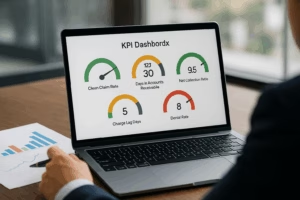If you’ve ever watched your team re-enter the same data into two systems, you know the “swivel-chair” problem. It’s not just annoying — it’s costly. Industry studies show that healthcare administrators spend up to 20% of their week navigating disconnected systems, toggling between EHRs, billing portals, and spreadsheets just to keep records aligned.
At Accelerated Medical Management Solutions (AMEDMS), we call this the “Swivel-Chair Gap.” It’s the silent killer of productivity that hides behind routine tasks — insurance updates, payment posting, or demographic corrections — all done twice (or three times) in separate systems that don’t talk.
Every extra click increases the chance of error. Miss one field, and a claim can bounce back or a patient record can fall out of sync. Multiply that across thousands of encounters, and your staff is trapped in manual chaos instead of managing care and revenue.
Why the Gap Exists
Most healthcare systems evolved piecemeal. A practice adds an EHR for charting, a PM system for scheduling, and a separate billing tool to meet payer requirements. Each one has its own database, rules, and formats — often using outdated HL7 or proprietary interfaces that don’t share data natively.
The result? Redundant entry, inconsistent patient records, and limited visibility into the full revenue picture.
How Integration Closes the Gap
True interoperability doesn’t mean ripping out your systems — it means connecting them intelligently. Modern API integrations and middleware tools bridge these silos without forcing expensive migrations.
AMEDMS uses automation overlays that link EHRs, PM systems, and billing tools so data passes automatically between platforms. Demographics, charges, payments, and claims sync in real time, eliminating the need for duplicate input.
Here’s what integration looks like in practice:
- Patient demographics entered once in the PM system automatically update in the billing tool.
- Payments posted in the clearinghouse flow back to the EHR without manual reconciliation.
- Denial codes trigger automatic workqueue updates instead of staff rekeying them.
For administrators and COOs, that’s a measurable win: less rework, faster billing cycles, and happier staff.
Choosing the Right Integration Path
There’s no one-size-fits-all approach. Some practices adopt EHR-native add-ons, while others leverage RPA (robotic process automation) or third-party middleware like Redox or Datica. AMEDMS helps organizations assess readiness, choose the right approach, and implement connectors that fit their compliance and cost goals.
Security and Compliance
Every connection must be secure. AMEDMS ensures HIPAA compliance with encrypted data transfers, role-based access controls, and detailed audit logs. A Business Associate Agreement (BAA) governs all integrations to protect patient information and meet regulatory standards.
Measuring the Results
Once systems are connected, the ROI is clear:
- 30–50% less manual data entry time
- Fewer claim rejections
- Improved reporting accuracy
- Higher staff satisfaction
The swivel-chair stops turning — and your data finally moves as fast as your care delivery.
Take the First Step: No-Cost Integration Readiness Scan
If you’re tired of watching staff re-enter the same data into multiple systems, start by understanding where your gaps are. AMEDMS offers a no-cost Integration Readiness Scan — a quick assessment that identifies interoperability opportunities, evaluates your current EHR and PM connections, and outlines fast wins to reduce redundancy.



